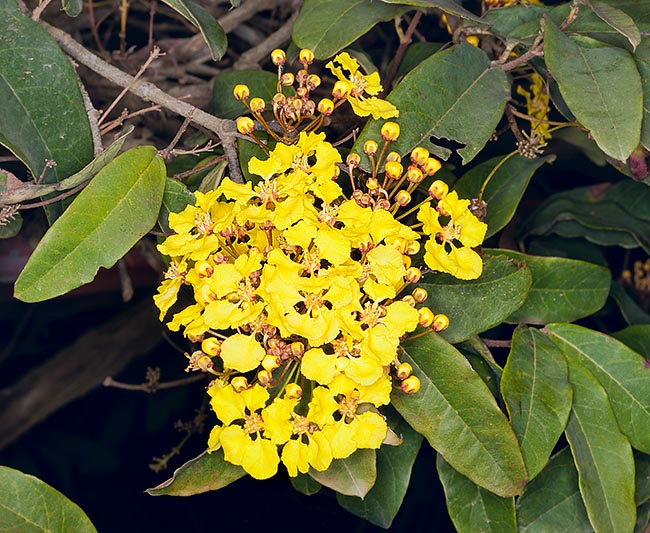Family : Malpighiaceae

Text © Pietro Puccio

English translation by Mario Beltramini

Banisteriopsis laevifolia is a 2-4 m sarmentose shrub. Easy to cultivate in the tropics © Giuseppe Mazza
The name of the genus is the combination of the name of the genus Banisteria and of the Greek term “ópsis” = look, resemblance; the name of the species is the combination of the Latin terms “laevis” = smooth, glossy, and “folium” = leaf, with obvious reference.
Common names: oncidium climber (English); barboleta do campo, cipò prata (Portuguese-Brazil).
The Banisteriopsis laevifolia (A. Juss.) B.Gates (1982) is an evergreen sarmentose bush, 2-4 m tall with the young branches covered by a thick whitish or golden tomentum, the old ones being glabrous and of dark brown colour.
The leaves, on a short peduncle, are opposite or ternate, simple and with entire margin, of olive green colour, with a shape varying from orbicular to ovate-lanceolate with pointed apex, 4-10 cm long and 2,5-6 cm broad, glossy on the upper page, slightly tomentose below and with 1-4 pairs of glands on the lateral nervations. Terminal umbel inflorescence, on long peduncle, carrying flowers of about 1,8 cm of diameter and 5 unguiculate petals (petals with long narrow base similar to a stem), of golden yellow colour, 0,5-0,8 cm long and 0,3-0,7 cm broad, with concave obovate lamina with ciliate-dentate margin, and 10 stamina. The fruit is a samara with flat membranaceous wing, pubescent, obliquely obovate, 1,6-3 cm long and 0,8-1,5 cm broad. It reproduces by seed at the temperature of 22-24 °C and by cutting.
Species with luminous flowering suitable for creating barriers and covering fences, cultivable in tropical and subtropical climate zones in full sun or slight shade, it can resist, for a very short period, to occasional drops in temperature up to about -1 °C. It is not particular about the soil, provided the same is well draining, and can stand, when adult, short dry periods, even if it takes advantage from regular waterings in the zones characterized by long, warm and dry summers.
Synonyms: Banisteria laevifolia A.Juss. (1833); Banisteria grata Griseb. (1886); Heteropterys micans Skottsb. (1901).
→ To appreciate the biodiversity within MALPIGHIACEAE family please click here.
